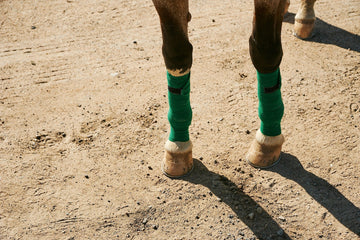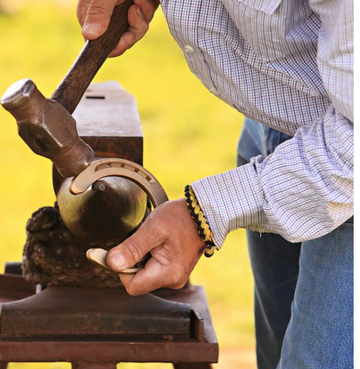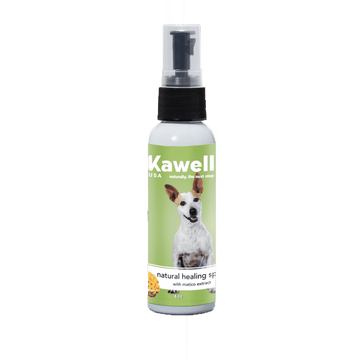Introduction to Horse Hoof Care
Caring for your horse’s hooves is one of the most important responsibilities for any horse owner. Regular hoof care is essential for preventing common hoof problems such as hoof cracks, white line disease, and thrush, all of which can lead to discomfort, lameness, and even long-term health issues if left untreated.
By prioritizing routine trimming, shoeing, and maintenance, you support healthy hoof growth and help your horse stay sound and active. Consistent hoof care not only addresses existing issues but also plays a vital role in preventing new problems from developing, ensuring your horse’s hooves remain strong and resilient throughout their life.
Understanding Hoof Anatomy and Health
A healthy horse hoof is a complex structure designed to support the horse’s weight and absorb shock with every step. The hoof wall forms the tough, outer layer that shields the sensitive inner tissues and provides structural integrity.
Beneath the hoof wall lies the sole, which cushions the foot and helps protect against impact. The frog, a V-shaped structure on the underside of the hoof, acts as a shock absorber and aids in circulation. Understanding these key components is crucial for effective hoof care, as issues like hoof cracks, laminitis, and other cracks often begin with problems in the hoof wall or sole.
Maintaining hoof health through regular care helps prevent these conditions and keeps your horse moving comfortably.

Common Hoof Issues and Problems
Horse owners frequently encounter hoof issues that can impact their horse’s comfort and performance. Hoof cracks are a widespread problem, often resulting from inadequate hoof care, poor nutrition, or challenging environmental conditions.
White line disease is another concern, causing separation within the hoof and leading to lameness if not addressed promptly. Thrush, a bacterial infection, thrives in damp environments and can cause pain and a foul odor in the hoof. Early detection and appropriate treatment are key to managing these hoof problems.
Regular hoof care, including cleaning, trimming, and working closely with experienced farriers and veterinarians, is essential for preventing infections, treating cracks, and ensuring your horse’s hooves remain healthy and strong.
Why Regular Horse Shoe Maintenance Is Essential
Proper hoof care is at the core of every healthy horse, and that starts with consistent horse shoe maintenance. Horseshoes protect the hooves from wear, help with traction, and support soundness, but they only work as intended if they’re cared for correctly. Neglecting shoe maintenance can lead to problems like loose nails, unbalanced gaits, and bacterial infections such as thrush or white line disease.
The shoeing process involves careful hoof trimming, selecting a properly shaped and balanced shoe, and securely attaching it with nails or adhesive to ensure hoof protection and balance.
Balanced hooves reduce stress and strain on bones and ligaments, promoting better movement and overall health. Choosing an experienced farrier to shoe horses is essential, as their expertise ensures a proper fit and supports long-term hoof health.
While steel has long been the traditional choice, innovative solutions like Kawell USA’s Copper Alloy Horseshoes offer unique benefits by providing antimicrobial protection and reducing the risk of common hoof ailments. Maintaining these advanced shoes correctly not only keeps your horse sound but also promotes long-term hoof health.

The Basics of Horse Shoe Maintenance
Horse shoe maintenance begins with observation. Every day, you should take a few minutes to examine your horse’s hooves and shoes. Check the feet for overall health and cleanliness. Check for loose nails, uneven wear, or trapped debris, as these small issues can escalate quickly. Inspect the nail holes for proper placement and any signs of damage to the hoof wall.
Routine farrier visits are equally important. Most horses need their shoes replaced or reset every four to six weeks to maintain proper balance and avoid excessive hoof growth that can strain the joints, tendons, and affect leg alignment. Regular trimming keeps the horse's feet healthy and supports correct leg and pastern alignment. Farriers assess the cannon bone and pastern alignment during shoeing to ensure optimal balance.
Between visits, horse owners play a critical role in keeping the shoes and hooves clean and healthy.
Why Copper Alloy Shoes Make Maintenance Easier
Steel shoes protect the hoof from mechanical wear, but they do nothing to combat microbial growth. Horses are shod with copper alloy shoes using the same process as traditional materials, ensuring proper fit and hoof protection. Horses often stand in damp bedding or muddy environments, exposing their hooves to bacteria and fungi that can weaken the hoof wall and frog.
Kawell USA’s Copper Alloy Horseshoes are designed to solve this problem. Made from a patented copper alloy (UNS Alloy No. C6915, EPA Registration #82012-3), these shoes kill 99% of bacteria and fungi on contact, dramatically lowering the risk of thrush and other infections.
Because copper alloy actively resists microbial buildup, horseshoe maintenance becomes less about fighting infections and more about simple cleaning and monitoring. Even with normal wear and exposure, copper’s antimicrobial properties never fade or wash away, making upkeep straightforward.
Benefits of Copper Alloy Horseshoes for Maintenance
-
Continuous antimicrobial protection that eliminates bacteria and fungus
-
8.53% impact absorption with every step to reduce stress on joints
-
Tarnish and abrasion resistant, so they don’t lose effectiveness over time
-
100% recyclable, eco-friendly material
-
Reduced veterinary and farrier costs by preventing infection-related damage
By choosing copper alloy shoes, you simplify your maintenance routine while protecting your horse’s hooves against some of the most common and costly problems.
Daily and Weekly Maintenance Practices
Even with copper alloy shoes, a consistent routine is key to keeping hooves healthy. Here’s how to maintain your horse’s shoes and hooves effectively.
Regular inspection of horse hooves is essential to detect cracks, ensure proper toe length, and provide adequate heel support. Always check the heel and heels for signs of imbalance or injury. Consulting an extension equine specialist can provide valuable advice on advanced hoof care and maintenance. Be vigilant for any foreign object, such as a street nail, that may penetrate the horse's hoof and require immediate treatments. Recognize a hot nail, which can cause lameness if driven into a sensitive area of the horse's hooves, and seek prompt intervention.
Daily Maintenance
Pick out your horse’s hooves at least once per day, clearing mud, manure, and stones. Check for any signs of thrush, such as foul odors or black residue around the frog. Look for loose nails or shoe movement, which can cause discomfort and uneven wear.
Weekly Maintenance
Use Kawell USA’s Natural Horse Hoof Paste to nourish the hoof and maintain proper moisture balance. The blend of pine oil, pine tar, petroleum jelly, and lard conditions the hoof horn while discouraging fungal and bacterial growth. Apply it to the hoof wall, sole, frog, and bars after cleaning.
Also, inspect the shoes for excessive wear. While copper alloy shoes are durable, consistent checks ensure your horse’s gait and balance remain correct until the next farrier visit.
Farrier Visits and Seasonal Checks
Schedule professional farrier visits every four to six weeks to reset or replace the shoes. Some horses, such as show horses or those with increased activity, may require more frequent trimming to maintain optimal hoof health and balance. During winter, hooves may grow slower, so it’s important to adjust the trimming and shoeing schedule accordingly, as care intervals may differ in colder months.
Discuss with your farrier the use of Kawell USA’s Copper Alloy Frog Inserts if your horse has deep sulci or a history of thrush. These inserts fit into heart bar shoes and provide targeted antimicrobial action where bacteria thrive most.
Tools for Hoof Care and Maintenance
Having the right tools is fundamental to effective hoof care and maintenance. A hoof pick is indispensable for removing dirt, stones, and debris from the hoof, helping to prevent infection and discomfort.
The hoof knife is used to trim and shape the hoof wall, while nippers are essential for trimming both the hoof wall and sole to maintain proper balance. Hoof moisturizers and conditioners can be applied to support hoof health, encourage hoof growth, and prevent cracking and dryness. Using these tools regularly helps address common hoof problems before they escalate.
Farriers and veterinarians can offer valuable advice on the best tools and techniques for your individual horse, ensuring that your hoof care routine is both thorough and effective.
Pairing Copper Alloy Shoes with a Complete Hoof Care System
Horse shoe maintenance isn’t just about the shoe—it’s about supporting the entire hoof. Comprehensive equine hoof care helps prevent health problems and supports your horse’s overall well-being. Combining copper alloy shoes with other Kawell USA products enhances protection and promotes stronger, healthier hooves. Caring for your horse's hooves as part of a complete maintenance routine is essential for long-term hoof health.
Copper Alloy Frog Inserts
These patented inserts, designed by farrier Esco Buff, PhD, APF-I, CF, kill bacteria and fungi on contact in the frog area. For horses with chronic thrush or deep sulci, they’re an invaluable addition to a maintenance plan.
Natural Horse Hoof Paste
This paste not only maintains ideal moisture levels but also acts as a barrier against excess water and contaminants. Daily or frequent use helps prevent cracks and keeps the hoof resilient.
Copper Alloy Bar Stock
For horses needing customized shoeing, farriers can use Kawell’s copper alloy bar stock to fabricate specialized shoes that retain the same antimicrobial and shock-absorbing benefits as our standard horseshoes.
Nutrition and Hoof Wellness
Proper nutrition is a cornerstone of hoof wellness and plays a significant role in promoting healthy hoof growth and preventing common hoof problems. A balanced diet rich in protein, vitamins, and minerals supports strong, resilient hooves. Supplements such as biotin and vitamin E can further enhance hoof health, especially for horses prone to brittle or slow-growing hooves.
Regular trimming and shoeing, combined with frequent trimming, help maintain optimal hoof shape and function. Horse owners should collaborate with their farrier and veterinarian to develop a comprehensive hoof care plan that includes proper nutrition, regular trimming, and shoeing. By focusing on nutrition and consistent care, you can help your horse achieve healthier hooves and reduce the risk of lameness and other hoof-related issues.
Expert Tips for Extending the Life of Your Horse’s Shoes
To get the most out of your copper alloy shoes and keep your horse comfortable year-round, follow these tips:
For added safety and comfort during grooming or shoeing, use a rubber mat in the workspace. This provides better traction and cushioning for both the horse and the farrier.
Keep stalls and turnout areas as dry as possible to minimize prolonged hoof exposure to moisture.
Frequently Asked Questions
How often do copper alloy horseshoes need to be replaced?
Like steel shoes, copper alloy shoes typically need to be reset or replaced every four to six weeks. The difference is that they maintain their antimicrobial properties throughout their lifespan and often wear more evenly.
Do copper alloy shoes prevent thrush completely?
While they can’t eliminate thrush risk entirely, copper alloy shoes kill the bacteria and fungi that cause infections. Combined with regular cleaning and frog inserts, they can prevent most cases.
Do copper alloy shoes tarnish over time?
Yes, copper tarnishes naturally, but this doesn’t reduce its effectiveness. In fact, the tarnishing process helps create copper salts, which continue to kill bacteria and fungi.
Are copper alloy shoes suitable for performance horses?
Absolutely. They reduce shock by over 8%, support joint health, and actively protect the hoof from infections, making them ideal for competitive horses.
Can I use Kawell’s Natural Hoof Paste with copper shoes?
Yes. The paste enhances the hoof’s moisture balance and overall health while complementing the antimicrobial benefits of copper shoes and inserts.
Conclusion
Maintaining your horse’s shoes is about more than keeping them secure—it’s about supporting the entire hoof for lasting health and soundness. By following a consistent cleaning and conditioning routine and choosing Kawell USA’s Copper Alloy Horseshoes, you can reduce the risks of thrush, white line disease, and costly veterinary issues.
Pairing these shoes with Natural Horse Hoof Paste and Copper Alloy Frog Inserts creates a maintenance system that keeps hooves resilient, balanced, and free from harmful microbes. With the right care and tools, your horse can stay comfortable, healthy, and ready for any discipline year-round.









